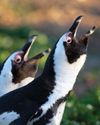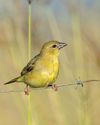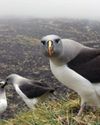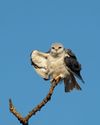
One of the biggest environmental challenges associated with generating power from wind is that birds, often raptors, are killed if they collide with the rapidly spinning wind turbine blades. Beyond locating turbines to avoid core habitat and flight paths of vulnerable species, there are few proven and cost-effective options to minimise the risk of collisions.
One potential solution, proposed in 2003 by cognitive scientist William Hodos of the University of Maryland, is to increase the visibility of the wind turbines to birds and reduce ‘motion smear’ – the blurring that occurs when an object moves across the retina at speed. To test this theory, Hodos conducted laboratory experiments on American Kestrels Falco sparverius, with promising results. The report suggested that painting one turbine blade black (and leaving the other two blades white) should be tested further.
هذه القصة مأخوذة من طبعة November - December 2020 من African Birdlife.
ابدأ النسخة التجريبية المجانية من Magzter GOLD لمدة 7 أيام للوصول إلى آلاف القصص المتميزة المنسقة وأكثر من 9,000 مجلة وصحيفة.
بالفعل مشترك ? تسجيل الدخول
هذه القصة مأخوذة من طبعة November - December 2020 من African Birdlife.
ابدأ النسخة التجريبية المجانية من Magzter GOLD لمدة 7 أيام للوصول إلى آلاف القصص المتميزة المنسقة وأكثر من 9,000 مجلة وصحيفة.
بالفعل مشترك? تسجيل الدخول

footloose IN FYNBOS
The Walker Bay Diversity Trail is a leisurely hike with a multitude of flowers, feathers and flavours along the way.

water & WINGS
WATER IS LIFE. As wildlife photographer Greg du Toit knows better than most.

winter wanderer
as summer becomes a memory in the south, the skies are a little quieter as the migrants have returned to the warming north. But one bird endemic to the southern African region takes its own little winter journey.

when perfect isn't enough
Egg signatures and forgeries in the cuckoo-drongo arms race

Southern SIGHTINGS
The late summer period naturally started quietening down after the midsummer excitement, but there were still some classy rarities on offer for birders all over the subregion. As always, none of the records included here have been adjudicated by any of the subregion's Rarities Committees.

prey for penguins
To stem the African Penguin's slide to extinction, government support for optimal no-take zones around South Africa's penguin colonies is critical.

agrochemicals and birds
By the year 2050, it is estimated that 171 million more hectares of agricultural land will be needed to feed a global population of 10 billion people.

arrivals and departures
The Mouse-Free Marion Project is committed to ensuring that breeding seabirds can return to a predator-free Marion Island.

MIDRAND marvel
Gauteng birders don't need to travel far to get their feathery fix. Midway between Johannesburg and Pretoria, Glen Austin Pan has become a favourite patch for this returnee expat.

a journey through the mysteries of moult
As a bird researcher in South Africa’s botanically diverse fynbos biome, I have come to regard bird ringing as part of my journey to understanding moult.